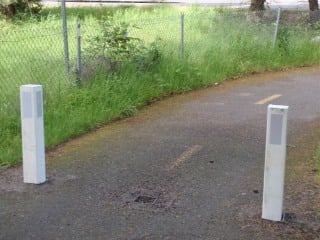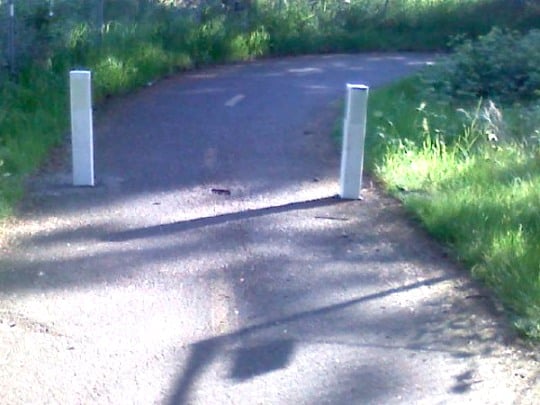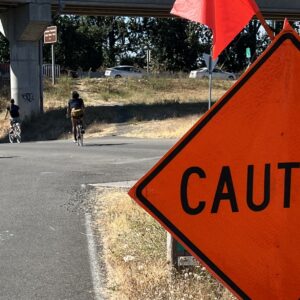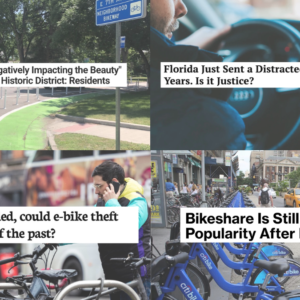
(Photo: Bob Kofstad/Washington DOT)
Last month, a woman driving a medium-sized sedan somehow managed to travel nearly two miles on the I-205 bike path before she panicked and a passerby on a bike called 911.
And it turns out this was the second such incident in the past few months. That’s what I heard today from Washington Department of Transportation spokeswoman Abbi Russell. I contacted WSDOT a few weeks ago after a reader told me that bollards had gone up at the entry to the path on SE 23rd Street. I was finally able to confirm that today with the man who put them there.
Bob Kofstad is the WSDOT maintenance supervisor for Area 1 which covers Vancouver. He told me during a phone call today that he still doesn’t know what exactly happened with that woman back on April 21st; but it caused him to visit the site and replace the bollards. “They’ve been missing for a few years,” he said, “and in the last 3-5 months we’ve had a couple cars go down that trail.”
The reason Kofstad says WSDOT hadn’t replaced the missing bollards sooner is because they kept getting stolen by metal thieves. “So we came up with a different design,” he explained, “We took a plastic fence post and filled it with concrete.”
Here’s another photo from a wider angle that was sent in by reader Eric Lanners:

The path is meant to have three bollards, but Kofstad says they replaced only the two on the outside. “It’s enough to keep the cars out, but we understand going through a narrow passage isn’t the best thing for bikes. The safety of bikers is what we’re worried about.” He estimates the path is 8-10 feet wide and the bollards narrow it down to about 6 feet.
If you ride on this path and you have feedback for WSDOT, or if you need to report any other incidents, contact Abbi Russell via phone at (360) 905-2058 or via email at russela [at] wsdot [dot] wa [dot] gov.





Thanks for reading.
BikePortland has served this community with independent community journalism since 2005. We rely on subscriptions from readers like you to survive. Your financial support is vital in keeping this valuable resource alive and well.
Please subscribe today to strengthen and expand our work.
Excellent. Maybe concrete-cast storm sewer grates are next?
Kudos for not replacing the center bollard.
Just like the last set, I fully expect metal scroungers will steal these for meth money by August. I noticed WSDOT stopped replacing the signage on the other end of the block and the adjacent WA 14 bicycle ramps that handle I205 bike traffic coming from / returning to the freeway long ago. Never mind reflective faced wood back signs instead of metal would probably have put an end to the signage thefts.
Did you read the article? They’re concrete. No metal.
Online articles are like instruction manuals. No one actually reads them.
They look like any other bollard that’s been there before: Thick metal filled with concrete.
Again. RTFM. They’re plastic fencing material filled with concrete. No metal is involved as described.
Yeah, READ THE M***** F***** !
Thank you John. 😉
I’ve been looking for some concrete bollards,where do I find these? Are they hard to pull out?
I’ve never met Rob Sadowsky, but I think I just heard him scream with delight when I saw those bollards.
I bet I could fit my smart car through that!!!!
Yup. Just looked it up. A Smart is about 5’3″ wide. So…the car2go lane is still open! (I kid. Good work, WSDOT!)
To be fair, a smart car will fit a standard Oregon bike lane with 9 inches to spare.
Totally could race my Mini Cooper through there like it’s the heist scene in The Italian Job.
Or one of those Smart Cars.
Hm. It seems like just replacing the middle bollard would have been better for cyclists and for keeping cars out. Having to squeeze between those two bollards with the hole for the third in between does not sound fun.
nope, cars could easily go around 1 in the middle, this is a better set-up. I’ve ridden this path lots of time, you hardly ever meet someone going the other way, right at that spot, it is fairly low traffic.
I agree, the bollard placement is also nonstandard in that the bollards are in the middle of the lane. Which is why previous sets of bollards have just used the center post. Could a car go around? Yeah, with effort, maybe. Getting through the soft mud might be tricky, though. Odd that they don’t put the bollard on the centerline where it belongs, but back around the gate that’s locked open, since that’d be a naturally narrow spot.
One night on the 205 path near Holgate or Division somewhere, I almost got creamed by a speeding moped-powered 5-cent can collector loaded to the gills with bags of (presumably) cans, with no lights, reflectors, etc (nor plates or insurance likely). Didn’t know who to call. Probably not Washington though.
FHWA has excellent guidance on bollard safety, and concrete-filled fenceposts are not the answer. Most motorists who make it onto trails are simply confused, not trying to intentionally drive on a bike trail.
Instead of a rigid post that can kill or maim cyclists, why not a flexible plastic delineator post that clearly marks the trail as closed to motor vehicles, but bends when struck by a cyclist?
See http://www.fhwa.dot.gov/environment/recreational_trails/guidance/accessibility_guidance/bollards_access.cfm for that and other alternatives to rigid bollards, about which FHWA says,
====
Even “properly” installed bollards constitute a serious and potentially fatal safety hazard to unwary trail users.
====
Also, as pictured, the bollards fail to meet MUTCD marking requirements. To reduce the risk of bollard impact, especially in following-rider situations, bollards are required to have yellow pavement striping warning of the upcoming hazard. You can see an example here: http://www.flickr.com/photos/jputnam/6290163475/
(In a following-rider accident, the first rider sees the bollard and is planning to avoid it; the second rider cannot see the bollard because of the rider in front. When the front rider dodges the bollard at the last moment, the following rider slams into it. This is a well-documented hazard of rigid bollards on bicycle facilities.)
White is the correct color for shoulder-bollards, in which the noncompliant part is the fact they’re in the lanes instead of just past the edgelines.
But if they’re in the paved path, they need to have the warning stripe envelope around them.
Right edge posts should never be in the path to start with. They need to be either moved to the shoulders and/or replaced by a yellow centerline post delineated with a median envelope. But, judging by the poor striping and signage maintenance on the Washington segment of the I 205 cycleway (save for the bicycles must exit signs going south), do you honestly think WSDOT actually cares about doing it even close to right? No, they just want to phone it in and do as little as possible to keep another car from getting stuck on their portion of the center bridgeway. Such is the norm for the Portland region, particularly the Washington half.
A couple years ago I saw a car use the 205 path as a cut through from Holman St to Airport Way.
It looks like someone could even get on there and go all the way to Marine Drive. It’s quite the shortcut…
A few hundred feet before the Marine Drive exit going southbound is a deep, very narrow channel, very sharp curve and a short segment hanging off a precipice. Best a driver trying that could go for would be to claim they thought it was the ramp to Airport Way, similar to what happened when Westside MAX opened.
For those who don’t remember, right at the start of morning rush hour on September 14, 1998 (the first Monday Sunset Transit Center and Westside MAX were open), a very drunk driver taking the trumpet ramp from 217 north to 26 west jumped the jersey barrier and drove into the tunnel skylight between ramps, falling into the tunnel from above. The driver said he thought the tunnel was the exit for 26 East. Trains in both directions used Platform 2 (the normally eastbound platform) and used Track 2 (the corresponding normally eastbound track) from the second crossover east (since the first one was in the tunnel and the car landed on that crossover) to Beaverton Transit Center, using Track A to cross over and Platform A (now the Red Line platform, but at the time used mostly for relief service limited and express trains in both directions) for westbound trains, returning to Track 1 between the Lombard and Hall crossings.
Josh, while you have a point, this kind of scenario is very unlikely in this area. I invite you to check out the trail before going all scare tactic.
Not as unlikely as you think, going northbound on 205, that winds up behind the curve. At night, particularly in the rain, that’s a hard to ride section (and would seriously benefit from WSDOT refreshing the centerline and edgelines; no idea why ODOT, PBOT and WSDOT seems to not care about ensuring these are properly maintained on 205, 84 and the 40 Mile Loop).
I guess, I’ve never had a problem with that area in the 6 months that I commuted that way.
Try it on a dark, windy and rainy night wearing glasses without running over what fell out of the trees.
My concern is that WSDOT should know the standards they’re supposed to be meeting… If they’ll do a noncompliant installation here, where else will they do it? What’s the point of WSDOT having well-researched and well-documented safety standards unless they’re going to follow them?
Despite the good intentions it appears this design fails to meet the recommended standards for bollard placement and material. If one in the middle is too easy for a car to drive around, two is not recommended as installed here. Three is, and if that means that the outside two need to be further apart so be it. It can’t really be that great a cost, can it?
What would be the point of a third?
The cost is the difference between a couple hundred dollars for new bollards, and a couple thousand to redo the bollard bases, which is often the difference between a supervisor saying “yeah, just go do it” versus needing to put together a project proposal and getting funding approved.
So unless you’re a “do it perfectly or don’t do it at all type” this seems a pretty good solution.
A standard resilient plastic delineator post will slip inside most bollard sockets, then just stomp the rest of the socket full of cold-patch to hold it. Conspicuous, inexpensive, and much less hazardous for a cyclist to run into. Around $45-50 for the post, and a $20 bag of cold patch asphalt will do more than a dozen posts.
I hope the concrete ones aren’t vandalized. Seems like you could crack them over time.
Best practices is an odd number of bollards, to reduce head-on conflicts.
If one in the middle isn’t enough ’cause cars will drive around, then three is a better choice than 2.
Ted Buehler
In my opinion the bollards should not be placed there at all unless the path is widened at that spot. This may be an overreaction to a problem that really does not exist, possibly due to surprising amount of media coverage it has received.
I live in Vancouver and have been commuting to my job in Portland practically daily for the past 13 years. Over that period of time I am aware only of the most recent incident (there may be others that I have not heard of). There are many more reported instances of cars entering a freeway the wrong way up an off ramp, often with the tragic result of a fatal accident. Yet WSDOT/ODOT do not rush out and install “tiger teeth” at those locations to prevent a recurrence. Most recently there was the incident of an 18-wheeler going the wrong way up the bridge. I came across that scene on my way to work about 45 minutes after it occurred.
The point where the bollards are has poor sight distance in both directions because of the curve there and vegetation. Many riders approach that spot at a fairly high rate of speed from both directions. I have experienced close encounters there in the past, both night and day (in winter I never see daylight on my bike). But we were able to comfortably adjust and avoid each other. One commenter above suggests that that is a low traffic area — not necessarily so; depends on the time of day and which day. Those two bollards are so close that only one bike at a time can pass through. The center bollard was removed some time ago, apparently as an “official act” because the sleeve holding the bollard has been cut down to the pavement elevation in order to prevent tire damage by riding over it.
I don’t see the need for a knee-jerk reaction to an incdent that rarely happens. And even should it happen, the path is so narrow and windy that the vehicle certainly couldn’t get up to much speed. On that note, I would have liked to see the driver re-tested, because there are more than sufficent clues to even the most unthinking driver to indicate that that is not a roadway. In the meantime, a more present potential hazard has been placed in the path of those of us who ride through there a couple times each day.